Purple cauliflower: description and photo
Recently, gardeners have been paying more and more attention to cauliflower. The direction of growing varieties with unusual colored heads, for example, a purple hue, is gaining particular popularity. Such a plant is interesting from an aesthetic point of view and has health benefits. In this article, we'll cover everything about purple cauliflower.
The content of the article
Origin and description of purple cauliflower
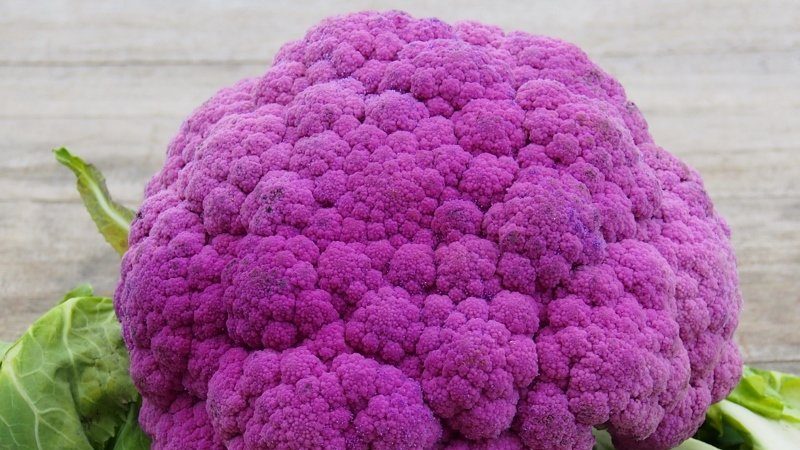
Since the 70s. XX For centuries, scientists have been breeding variegated varieties of cauliflower. Basically, all work was carried out in the Mediterranean countries, as the most suitable for the climate.
In the future, the experience of breeding new varieties was extended to the rest of Europe. For example, the Swiss company Syngeta contributed to the introduction of purple cauliflower in the UK. Andrew Cocker, an employee of the firm, said they were able to achieve a bright, lasting color without using GMO technology. When breeding a purple variety, breeders used the selection of classic samples with natural mutation and the use of natural pigments that affect the color of the plant head.
Varieties of purple and violet color in useful properties slightly differ from the original variety, and even exceed in taste. However, they are inferior to white varieties in terms of yield. The head of cabbage, called the head in cauliflower, has a rounded, slightly flattened shape and is surrounded by dense green leaves.
Varieties and hybrids of purple cauliflower
Now gardeners have a large selection of seed planting material. In addition to varieties, there are hybrids on the market, thanks to which it became possible to harvest purple cauliflower almost until late autumn.
Purple Queen F1
Refers to early maturing hybrids. Has a deep purple color. Slightly flattened rounded heads of cabbage ripen in 70-80 days. Fresh inflorescences are allowed. Looks great when decorating dishes.
Amethyst F1
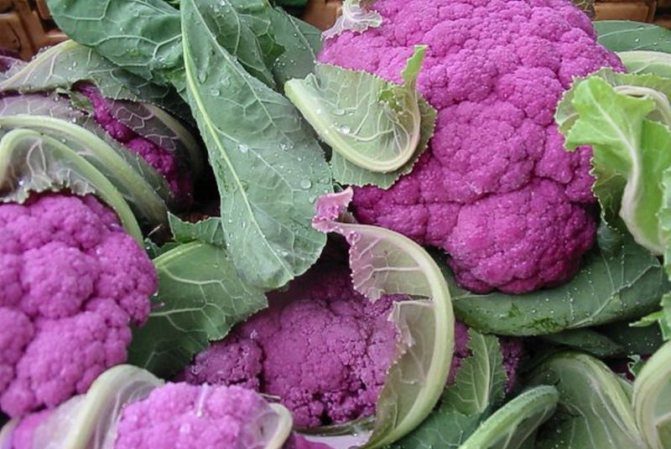
Refers to medium early hybrids. Has a rich purple inflorescences. Its peculiarity is the ability to self-cover with large, dense leaves with a waxy film. Heads of cabbage ripen in 70-80 days. A high quality crop with aligned heads is obtained by sowing in spring and summer.
The recommended date is from mid-May. Especially good when preparing colored salad, as well as in vegetable frozen mixtures after 7 minutes of boiling. The optimal weight of the heads is 0.6-1.2 kg - and their color is achieved by observing the planting scheme (0.4x0.4 m) and the rules of agricultural technology.
Graffiti F1
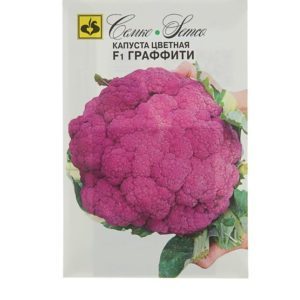
Mid-early hybrid. Rounded-flat heads are bumpy, saturated dark purple in color, reaching a weight of up to 1.1 kg. High-yielding - 5-6 kg per 1 m². Recommended seedling planting method. 30-day seedlings reach technical ripeness in 70-80 days.
The hybrid is distinguished by its high commercial qualities. In temperate climates it can be grown all-season, and in subtropical climates, winter cultivation is allowed. Possesses excellent taste, suitable for consumption raw.
Purple ball
Refers to high-yielding mid-season varieties. The period from germination to harvest is 110-120 days. The semicircular heads have a deep purple-purple color.They are characterized by high commercial qualities. The heads are dense in structure, weighing up to 1.4 kg. Suitable for storage.
Cabbage is resistant to autumn frosts and some diseases. The plant is medium-sized, the head is medium-leafy. Suitable for preparing vegetable side dishes, mixtures, freezing. It is not eaten raw. May lose color brightness during cooking.
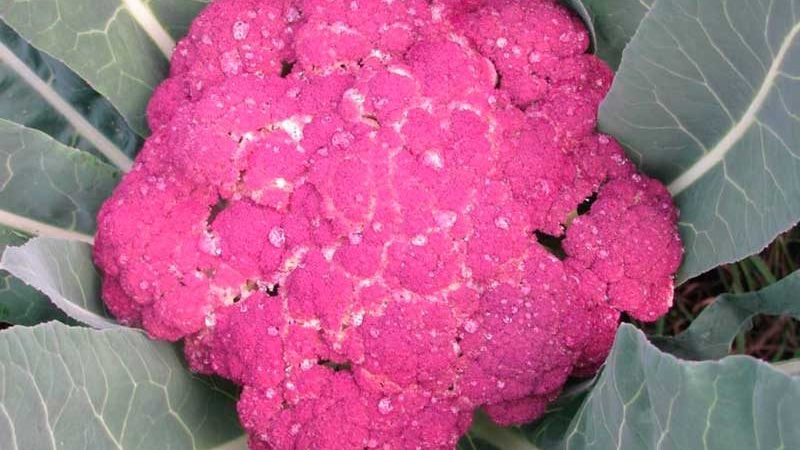
Purple
The variety is mid-season - 110-120 days, high-yielding. The heads are round-flat, deep purple-purple color. They are dense in structure, weighing up to 1.5 kg. The cold-hardy variety is resistant to some diseases.
Differs in high taste. Suitable for long-term storage in a cold room or refrigerator, as well as for freezing. Suitable for preparing hot side dishes and canning.
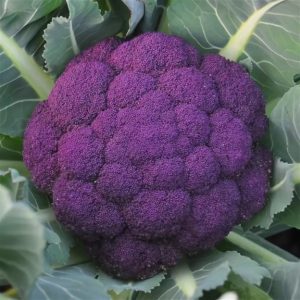
Sicily purple
Medium late variety - 140-150 days. Has a hemispherical ink-purple head. It is very dense in structure, weighing up to 1.2 kg. The cover of the head with leaves is average. There is no friability of inflorescences.
It is characterized by a compact, erect rosette and amicable ripening. Requires tight deadlines for cleaning. To obtain a decent harvest when planting in a permanent place, it is necessary to observe the accuracy - 4 seedlings per 1 m².
Clara's corals
Refers to high-yielding, mid-season varieties - from germination to harvest 110-120 days. It has valuable dietary properties. The heads are round-flat, violet-purple in color. The structure is dense, even, weighing up to 1.5 kg, with a partial sheet covering. The variety is cold-resistant. Differs in high taste.
Suitable for long-term storage in a cold room or refrigerator, as well as for freezing. Suitable for salads, hot side dishes and canning. Productivity - up to 3.6 kg per 1 m².
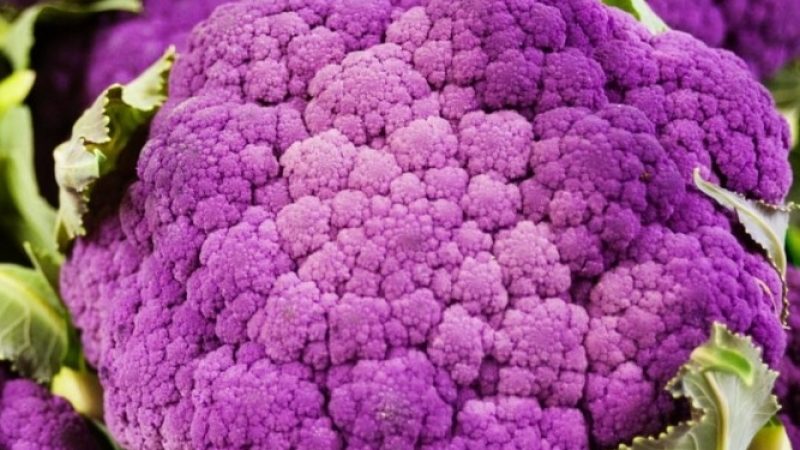
Growing methods
The agricultural technique of purple is practically no different from the cultivation of cauliflower of other colors. The purple vegetable can be planted with or without seedlings.
Growing seedlings
This method allows the rational use of seed material to meet the requirements for planting accuracy. Purple cabbage does not like transplanting, therefore, when sowing, they use cups and seedling tablets.
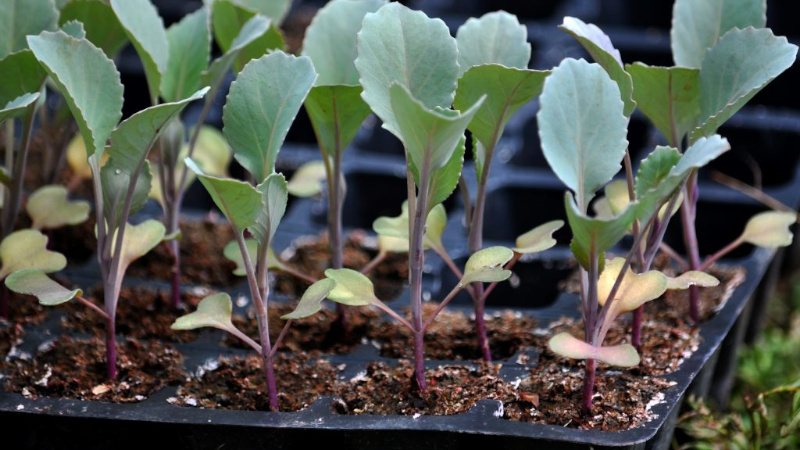
Young plants are best grown in two stages:
- sow from the second half of March and plant in open ground in late April - early May;
- sow on May 14-26 in a cold nursery and plant the plants permanently in June.
Immediately before sowing, the seeds must be treated with a solution of potassium permanganate. 1% composition is prepared from 5 g of potassium permanganate and 500 ml of water. The seeds are kept in this solution for 20 minutes, then washed and planted in the ground.
The seedling soil mixture is prepared from equal parts of sand and peat with the addition of fertilizers. Potassium nitrate and superphosphate are added per 10 kg of soil 0.5 tsp. fertilizers. With a lack of nutrition, the leaves of plants will curl and deform, and the inflorescences will rot.
For seed germination, a soil temperature of + 16 ... + 18 ° C is required.
When the first shoots appear, the plants are sent for hardening in a cool place.
Attention! At daytime temperatures above + 8 ° C, the seedlings will stretch and weaken. This threatens the death of plants after transplantation. into open ground.
In addition to hardening, seedlings require feeding. The first is applied after the formation of 2 true leaves. The second - before planting in open ground for a few days.
After 35-40 days after germination, the seedlings are suitable for transplanting to a permanent place. The general arrangement of plants is 0.3x0.5 m. Certain varieties require a different density. In this case, you must adhere to the recommendations of the breeders.
After planting plants in open ground, watering is stopped for several days so that the seedlings take root better. The roots will go deeper into the soil and the cabbage will be more resilient.
Growing without seedlings
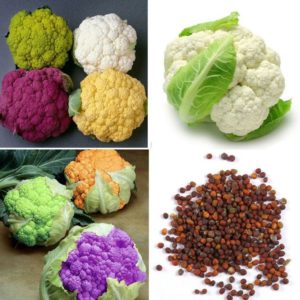
Growing purple cabbage without seedlings, that is, sowing seeds in open ground, is also better in 2 stages:
- under the film in late April - early May;
- without film cover in late June - early July.
The disadvantage of this method is the excessive consumption of seeds. Some varieties require planting accuracy, which can only be achieved by thickened sowing and later by removing excess plants. However, the method without seedlings allows you to get the harvest at a later date. Some varieties ripen until October.
General rules of agricultural technology
Cauliflower is very picky about the soil. Increased acidity of the soil inhibits the formation of ovaries of inflorescences. This cabbage does not tolerate temperature changes, so you should be very careful when choosing a growing place. Plants should be planted in a sunny area, protected from drafts.
Before planting, the soil in the garden bed is fertilized with rotted compost. Each plant hole is powdered with lime to avoid contamination with cabbage keel.
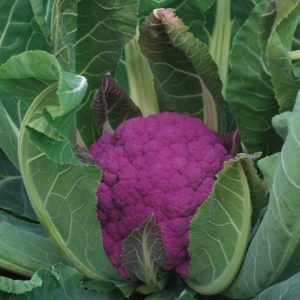 Basic care includes watering with a large volume of water under the root, occasionally spraying the leaves. This cabbage absolutely does not tolerate overdrying.
Basic care includes watering with a large volume of water under the root, occasionally spraying the leaves. This cabbage absolutely does not tolerate overdrying.
It is recommended to feed 2-3 times with mullein infusion.
Regular weeding, loosening and hilling help strengthen the stem and rhizome. Purple heads will knot and ripen faster.
Shading is required on particularly hot days. If the top layer of the earth dries up, mulching is necessary. It will protect the plant roots from overheating and keep the soil moist.
Usually, 10 days after the formation of inflorescences, the first crop is already harvested. Overripe heads lose their taste and are prone to crumbling.
Reference. The very last, late harvest, which is harvested in October, can be saved until the New Year holidays. The plant is dug up with a root and a clod of earth, planted in a suitable container and removed to a cool cellar. At temperatures from +2 to + 5 ° C, cabbage will grow. The main condition for such long-term preservation is the absence of damage to the outlet.
Useful properties of lilac cauliflower
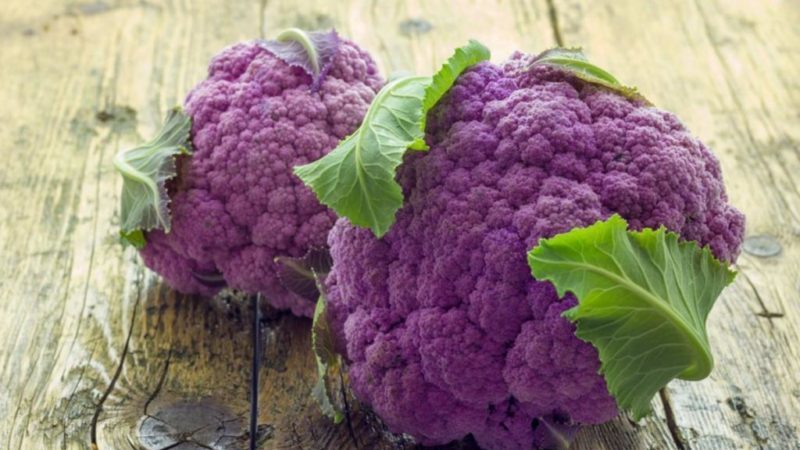
The high content of anthocyanins in the inflorescences, which provide a bright purple color, helps prevent cardiovascular diseases.
It has already been established that regular consumption of this vegetable reduces the risk of developing:
- diabetes mellitus;
- liver failure;
- dysfunction of the gallbladder;
- vascular atherosclerosis;
- cancer.
Purple cauliflower is distinguished from white by a more delicate taste and quick cooking.
When cooking purple inflorescences, it is worth considering that the water in which they will be boiled must be acidified (for example, with citric acid) in order to maintain the brightness of the color. Steaming or battering will help prevent discoloration. Italians advise replacing the potato side dish with such a side dish at least once a week.
Conclusion
Growing cauliflower is a fun activity that will bring beauty to the site and undeniable health benefits. Correctly selected varieties and compliance with the requirements of agricultural technology will allow you to get a harvest for a long time.